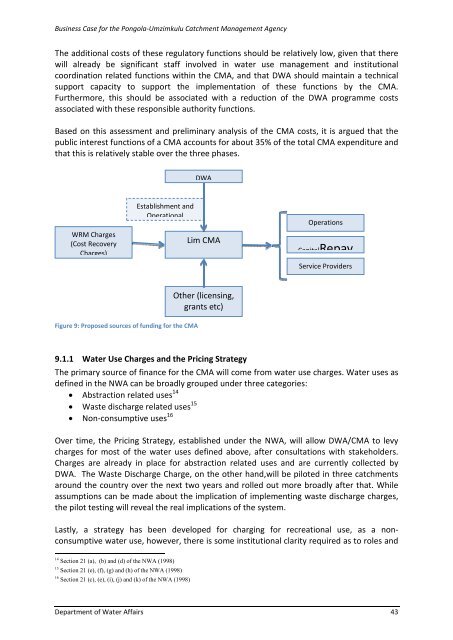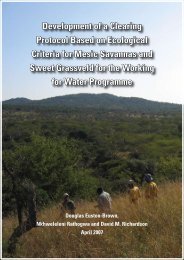Business Case forthe Pongola-Umzimkulu Catchment Management ...
Business Case forthe Pongola-Umzimkulu Catchment Management ...
Business Case forthe Pongola-Umzimkulu Catchment Management ...
Create successful ePaper yourself
Turn your PDF publications into a flip-book with our unique Google optimized e-Paper software.
<strong>Business</strong> <strong>Case</strong> for the <strong>Pongola</strong>-<strong>Umzimkulu</strong> <strong>Catchment</strong> <strong>Management</strong> Agency<br />
The additional costs of these regulatory functions should be relatively low, given that there<br />
will already be significant staff involved in water use management and institutional<br />
coordination related functions within the CMA, and that DWA should maintain a technical<br />
support capacity to support the implementation of these functions by the CMA.<br />
Furthermore, this should be associated with a reduction of the DWA programme costs<br />
associated with these responsible authority functions.<br />
Based on this assessment and preliminary analysis of the CMA costs, it is argued that the<br />
public interest functions of a CMA accounts for about 35% of the total CMA expenditure and<br />
that this is relatively stable over the three phases.<br />
DWA<br />
WRM Charges<br />
(Cost Recovery<br />
Charges)<br />
Establishment and<br />
Operational<br />
Lim CMA<br />
Operations<br />
CapitalRepay<br />
Service Providers<br />
Other (licensing,<br />
grants etc)<br />
Figure 9: Proposed sources of funding for the CMA<br />
9.1.1 Water Use Charges and the Pricing Strategy<br />
The primary source of finance for the CMA will come from water use charges. Water uses as<br />
defined in the NWA can be broadly grouped under three categories:<br />
• Abstraction related uses 14<br />
• Waste discharge related uses 15<br />
• Non-consumptive uses 16<br />
Over time, the Pricing Strategy, established under the NWA, will allow DWA/CMA to levy<br />
charges for most of the water uses defined above, after consultations with stakeholders.<br />
Charges are already in place for abstraction related uses and are currently collected by<br />
DWA. The Waste Discharge Charge, on the other hand,will be piloted in three catchments<br />
around the country over the next two years and rolled out more broadly after that. While<br />
assumptions can be made about the implication of implementing waste discharge charges,<br />
the pilot testing will reveal the real implications of the system.<br />
Lastly, a strategy has been developed for charging for recreational use, as a nonconsumptive<br />
water use, however, there is some institutional clarity required as to roles and<br />
14 Section 21 (a), (b) and (d) of the NWA (1998)<br />
15 Section 21 (e), (f), (g) and (h) of the NWA (1998)<br />
16 Section 21 (c), (e), (i), (j) and (k) of the NWA (1998)<br />
Department of Water Affairs 43
















